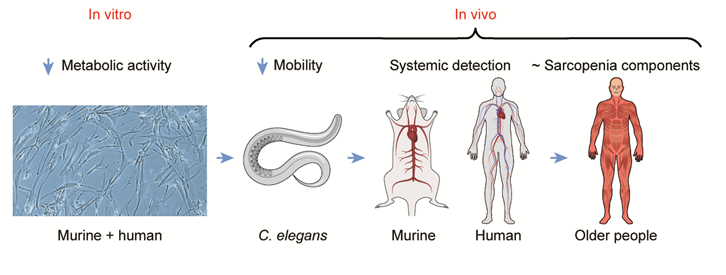Quorum sensing molecules (QSM) are characteristic bacterial products, constitutively produced by living bacteria and exhibiting an increased and/or altered production in “stress” conditions. Mainly three groups can be distinguished: the N-acyl-homoserine-lactones (AHL, mainly produced by Gram-negative bacteria), the quorum sensing peptides (QSP, mainly produced by Gram-positive bacteria) and the furanosyl borates (AI-2 [autoinducer-2], produced by Gram-positive as well as Gram-negative bacteria). Quorum sensing peptides have long been considered as intra-bacterial communication molecules only [1, 2]. However, nowadays, it is generally accepted that this communication is not limited to the bacteria themselves, but also play a role in for example colorectal cancer and the central nervous system. We recently identified iAM373, a QSP produced by E. faecalis, to be an inducer of sarcopenia [3, 4]. iAM373 was shown to 1) decrease metabolic activity in vitro, 2) induce a sarcopenic phenotype in C. elegans in vivo, 3) be present in murine and human plasma and 4) correlate with muscle mass and gait speed in older people [4]. These findings offer the first demonstration that quorum sensing molecules are involved in muscle wasting diseases such as sarcopenia, opening new diagnostic and therapeutic dimensions.

Bacterial Quorum Sensing Peptides and their muscle talk

[1] M.M. Kendall, V. Sperandio, What a Dinner Party! Mechanisms and Functions of Interkingdom Signaling in Host-Pathogen Associations, Mbio 7(2) (2016) 14.
[2] E. Wynendaele, A. Bronselaer, J. Nielandt, M. D'Hondt, S. Stalmans, N. Bracke, F. Verbeke, C. Van De Wiele, G. De Tre, B. De Spiegeleer, Quorumpeps database: chemical space, microbial origin and functionality of quorum sensing peptides, Nucleic Acids Research 41(D1) (2013) D655-D659.
[3] A. De Spiegeleer, D. Elewaut, N. Van den Noortgate, Y. Janssens, N. Debunne, S. Van Langenhove, S. Govindarajan, B. De Spiegeleer, E. Wynendaele, Quorum sensing molecules as a novel microbial factor impacting muscle cells, Biochimica Et Biophysica Acta-Molecular Basis of Disease 1866(3) (2020).
[4] A. De Spiegeleer, E. Wynendaele, N. Debunne, B. Braeckman, M. De Mey, A. Descamps, J. Coudenys, L. Crombez, F. Verbeke, D. Elewaut, Bacterial Quorum Sensing Peptides and Sarcopenia: a role for iAM373, Clinical and Translational Medicine (2022) Revised manuscript under review.

